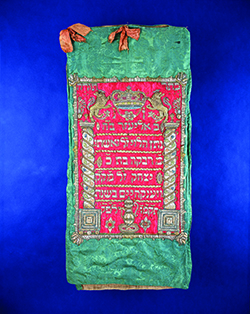Arts
Exhibit
Now We Know: Early America Was Religiously Diverse

From the earliest days of the United States, the Jewish people were a vocal minority standing up for religious freedom.
That spirit is captured in George Washington’s letter to Touro Synagogue in Newport, R.I., America’s oldest Jewish house of worship still standing. Religious freedom goes beyond tolerance, Washington wrote; it means that both the majority and minority have the same rights.
“And that is why the early experience of the Jewish community in America is so important, because they were always there saying, ‘What about our rights? Is it only going to be the rights of the majority, or are we going to take this idea of religious freedom seriously?’” said Peter Manseau, the new Lilly Endowment Curator of American Religious History at the Smithsonian Institution’s National Museum of American History.
A copy of Washington’s letter is part of the museum’s new exhibit, “Religion in Early America,” which open on June 28 and runs through June 2018.
Manseau, 42, is the author of One Nation, Under Gods, a look at America’s spiritual history. He wrote his doctoral dissertation on American Yiddish literature and won Hadassah Magazine’s Ribalow Prize for his novel Songs for the Butcher’s Daughter. The exhibit, he noted, “grew out of a recognition that you can’t really tell the story of American history without dealing with religion in all its variety.”
“Religion in Early America” focuses on a specific era: 1630 to 1830. The relics on display are culled from Protestant Christianity, the largest of the early faith-based communities, as well as Catholicism, African traditions brought in by the slave population, Native American beliefs, Islam, Mormonism and, of course, Judaism.

The exhibit is bookended by two impressive objects. Visitors are greeted by an 800-pound church bell made by Paul Revere in 1802 that hung in a Unitarian church in Maine.
At the end of the exhibit is a collapsible pulpit used by popular 18th-century preacher George Whitefield in over 2,000 open-air sermons. Whitefield, associated with the founding of the Methodist Church, preached during the First Great Awakening, a time when increased devotion had Americans seeking worship outside the conventional church experience.
Between the bell and pulpit and scattered among the more than 50 national treasures are stories of the Jewish experience. There are displays on pioneers such as Rebecca Gratz of Philadelphia as well as items such as a burnt Torah scroll from New York’s Congregation Shearith Israel, the oldest Jewish congregation in the United States.
The Torah scroll, shown in a section on worship in the Mid-Atlantic region, symbolizes the surrounding drama of the American Revolution. In 1776, British and Hessian soldiers took New York and the Jews fled—most were on the side of independence. Hessian soldiers set fire to Shearith Israel, damaging the building and the Torah scrolls. The burn marks on the scrolls function, in a way, as a photograph. “You can see this moment frozen in time,” Manseau said, “by seeing the parchment itself curled by the fire more than two centuries ago.”
The display on worship juxtaposes its Jewish items with extraordinary pieces of Americana. Next to the scroll is a manuscript page from the Book of Mormon and, perhaps even more surprising, the only existing Islamic religious text by a Muslim enslaved in the United States, from the early 19th century.
Gratz is one of eight people—and the only Jew—in a part of the exhibit entitled “Representative Life,” depicting people emblematic of religious diversity. She cofounded several philanthropic organizations dedicated to women and children and bolstered Jewish education.
A companion book to the exhibit, Objects of Devotion: Religion in Early America, expands on the evolution of faith in this country. However, viewing the exhibit paints a vibrant picture of the range and richness of early worship, Manseau noted.
“I wanted visitors to understand that religion in early in America is much more diverse than they might have understood,” he said. “It was really this diversity that created the practical need to have some type of religious freedom.”










 Facebook
Facebook Instagram
Instagram Twitter
Twitter
Leave a Reply